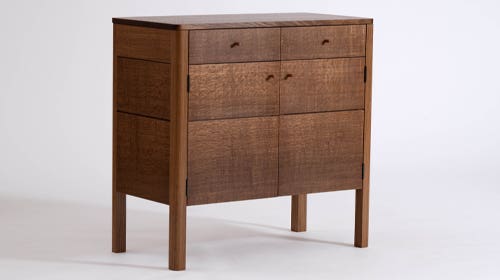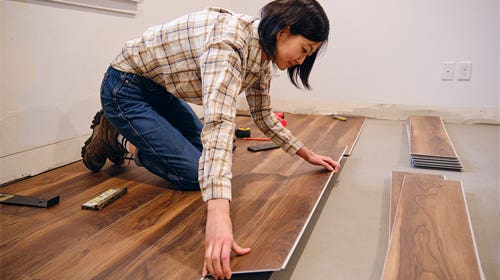Cherry sales are stable as price dips
Quality of product used for fine furniture, cabinetry and architectural millwork improves thanks to fewer overseas sales {loadposition position10} Because of a substantial drop in the cherry export market, domestic…
Quality of product used for fine furniture, cabinetry and architectural millwork improves thanks to fewer overseas sales
{loadposition position10}
Because of a substantial drop in the cherry export market, domestic dealers report an improvement in the quality of cherry available and also a drop in price. For many retail dealers, the cost of cherry has dropped substantially within the last year, which combined with the increased quality, has maintained sales at a reasonable level during a difficult time for wood markets. But even for some veteran wood dealers, it is currently a confusing business.
"For everything, prices have come down, nothing is what it was," says Jerry Anton of O'Shea Lumber, a wholesaler in Glen Rock, Pa. "I used to know something about the lumber business, I'm not sure I do anymore - just with pricing and whatnot, it's hard to know. The markets have been dropping, but I think they are starting to stabilize. Demand has been down. As far as I can see, everybody has cut back. The cherry and the maples are still going OK - poplar and things like that - but again, it is hard to judge what is happening."
Black cherry (Prunus serotina) is also known as wild cherry, wild black cherry, choke cherry, cabinet cherry and rum cherry, and grows from Canada south to central Florida and portions of Mexico and Guatemala. Its highest concentration is in Pennsylvania, which supplies about 70 percent of the country's cherry, although it only represents 3 to 4 percent of the Appalachian Forest. Black cherry trees reach heights between 80' and 100' with diameters of 2'-3'. The heartwood is pinkish-brown to reddish-brown with a distinctive golden luster. The sapwood is narrow and is a white to reddish-brown color.
"Many of the logs that we're getting exported are getting sawn [in this country] so the quality of the lumber getting produced now is probably better than it has been in possibly a decade," says Lou Irion or Irion Lumber in Wellsboro, Pa. "The problem for the customer in the domestic market was that people were so tired of getting junk. They said 'If this is cherry, we don't want it,' and that was a consequence of a really strong export market and the fact that just about everything nice was going overseas. So the quality is way, way up, but it's going to take awhile for customers to realize that the quality is back to where it should have been."
Black cherry is used extensively for fine furniture, cabinetry and architectural millwork and, to a lesser degree, musical instruments, professional and scientific instruments, novelty items, toys, and veneer. Burls and crotches usually go directly to the veneer market.
"Our sales of cherry have been pretty strong," says Steve Wall, owner of Steve Wall Lumber Co. in Mayodan, N.C. "Of course, the wholesale prices have come down a little bit. I just bought a load of 6' lengths that are really pretty - we're offering a special on that, 100' bundles of 6' length, it's clear one face and about 90 percent the other face. Cherry is still pretty strong for us. It goes mostly into the furniture and millwork things that we're specializing in."
"Cherry sales are good, probably because I have good quality stuff," says Bob Hansen of Badger Hardwoods of Wisconsin in Walworth, Wis. "Most of my customers are cabinet shops, but I have a lot of walk-in guys that are just building stuff. The Shaker movement, the Arts and Crafts stuff is really strong. There is the simplicity to the design."
Cherry is sensitive to UV light and changes to a reddish-brown, mahogany color upon exposure. It works well with hand and power tools, polishes to an excellent finish, and is dimensionally stable. The wood is straight-grained and is easily machined. It saws cleanly, turns well and planes excellently. Cherry holds screws and nails well and glues well.
"Cherry is kind of slow, but it is selling and it seems like there is more interest in the better quality stuff," Irion says. "What we see in the industry, especially here where we are pretty close to the cherry capital of northern Pennsylvania, is a lot of the mills are not cutting any cherry. If they have logs in the woods, they are trying not to bring them in and, if they're bringing them in, they're trying not to saw them. Their inventories aren't moving in cherry, so why saw any more? So everybody is doing everything they can to try and avoid cutting it."
Retail prices for 100 bf of kiln-dried, 4/4 FAS black cherry, surfaced on two sides, ranged from $5.10 to $6/bf in the Northeast; $5.45 to $6/bf in the Southeast; $5.20 to $6.10/bf in the Midwest; and $6.40 to $7/bf in the West.
Wholesale prices for 1,000 bf of kiln-dried 4/4 FAS black cherry ranged from $4,900 to $5,250/mbf in the Northeast; $5,200 to $5,775/mbf in the Southeast; $5,100 to $5,550/mbf in the Midwest; and $6,200 to $6,450/mbf in the West.
This article originally appeared in the August 2009 issue.







